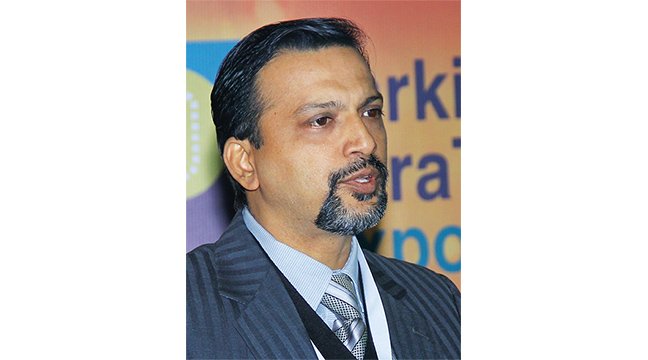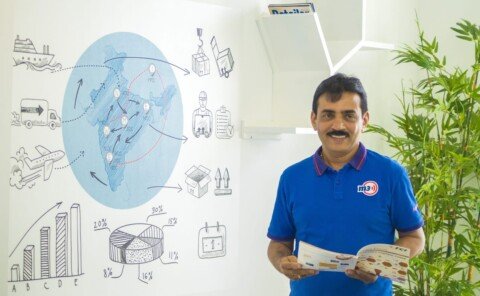Headquartered in Japan, NEC started operations in India in the 1950s and ever since been a key partner in India’s technology growth story. While continuing to accelerate its growth through innovative new services and solutions, NEC in India expanded its business from telecommunications to public safety, logistics, transportation, retail, finance, unified communication and IT platforms, serving state institutions, businesses, as well as individuals over the years. NEC has its head office in Noida and regional offices in New Delhi, Ahmedabad, Bengaluru, Chennai, Mumbai, and Gujarat. With its multiple Centres of Excellence (COEs) for analytics platform solutions, Big Data, biometrics, mobile and retail, NEC India is currently focussed on further building its product portfolio alongside contactless technology, as the scope and demand are high in various sectors, besides the need for brand-building tools in the era of ‘New Normal’. Debasish Debsikdar, AVP and SBU Head– Transportation & Logistics Division, NEC Corporation India says the company’s strong commitment to the country and India’s growing importance to the NEC Group’s global business echoes in their ‘India Go Big’ initiative that leverages solution development and delivery capability from India to aid multinational business growth. In fact, the company’s successes over time are a testament to the value their solutions deliver, empowering technology-based innovation that continues to serve customers in the truest sense of the word. Edited excerpts from his interaction with Upamanyu Borah.
How did you navigate the twist and turns of the current environment? What are the main trends you found across the sector considering your field of business and related opportunities in the market?
Under the brand’s purpose of ‘orchestrating a brighter world’, we are committed to using digital technology to help solve problems in the real world, embracing critical values like safety, security, efficiency, and quality. Last year, we saw the world adopting what NEC has been practicing as DNA and as a way of life for over 121 years now, i.e. leading ahead with an innovation-first mindset to realise a sustainable digital society that empowers everyone. Furthermore, the latest rebranding to NEC Corporation India (NEC) and leadership restructuring represents our team’s synchronised energies in the ‘New Normal’.
We expect to see the following trends in the coming years.
- Increase in online freight platforms and aggregators: Given the need for low entry barriers and less capital investment compared to setting up an asset-based business model.
- Innovation in the digitisation of processes: Digitalisation and technology adoption is already transforming the mobility segments and is expected to be the most impactful trend in the near future.
- Wide span FASTag adoption: This year we have seen E-Way Bill integrated with FASTag to track goods movement and curb tax evasion. We will soon find FASTag acceptance at petrol pumps for fueling, and as a pollution certificate validator. It could be used to pay parking fees at malls, airports, and other private parking lots. Going further and as compliance measure, FASTag will be integrated with vehicle insurance. Without insurance in place FASTag can’t be recharged and therefore services can’t be availed.
- Mobility industry to support Manufacturing in India: As India focusses on the Atmanirbhar Bharat initiative, manufacturing in India holds the potential to contribute up to 25-30% of the GDP by 2025. Given the connection to manufacturing, the logistics and transportation industry is expected to play a vital role in supporting the manufacturing industry for the exports and imports in our country.
Are you being opportunistic in picking up pace in this line of business considering that there has been a boom of digital solutions in India’s logistics industry? Other than simple growth, where are your investments currently directed towards?
The proposed logistics policy by the Government of India aims to eliminate inefficiencies and reduce costs by removing bottlenecks in the logistics value chain. The integration of computing devices enables interoperability by linking people, data, processes, and reducing human errors, which will be a game-changer for the industry. In my opinion, a skilled workforce will play an essential role in implementing digitisation, which involves cloud computing, automation, AI, IoT, Big Data, and Blockchain technology, etc.
From an investment perspective, the emphasis and focus Japan has on India is massive. NEC Corporation India has good support from the global team, and is looking for opportunities to grow. Our India team actively works with NEC’s team in Japan to leverage the knowledge and best practices across geographies.
We are currently in the process of creating global Centres of Excellence (COEs) in India across multiple domains. Additionally, NEC’s ‘India Go Big’ initiative aptly defines the unique scale of growth that India offers.
Could you elaborate on the weak links/challenges present in the ecosystem and how the National Logistics Policy may prove immensely beneficial?
The logistics sector in India has remained fragmented and unregulated, despite its centrality to economic growth. Compared to developed countries, some existing challenges that the Indian logistics sector faces include less transparency, disconnected transport networks, higher lead times, and lack of centralised monitoring system to enable real-time decision-making.
The National Logistics Policy aims to ensure the seamless movement of goods across the country with the integration of emerging technology. Additionally, it will lead the industry to better employ human-machine partnerships to facilitate improved operational efficiency and structured development of the logistics sector. Furthermore, it will truly accelerate the mission of Make in India.
How have you seen the needs of your clients develop and evolve over the last few years? How has it changed your attitude to innovations in the field and the future role of NEC in sustaining the same?
There is no denying that the industry’s perception of digital adoption has amplified with no compromises on an excellent quality product. Today, C-Suite business leaders acknowledge the value of a well-orchestrated logistics system—using emerging technology solutions and a seamless supply chain mechanism.
At NEC, we aim to provide the best possible solutions that resolve current issues and work towards bringing a brighter future for all.
Our customers realise the premium technology and scalability of our solutions and the impact they bring on the overall industry ecosystem (including life of end-users). We introduce our clients to breakthrough technology that delivers incredible business outcomes, and they have all the reasons to embrace it.
NEC Corporation India has always been at the forefront of the country’s digital transformation and we will continue to partner with the government for various projects.
Supply chain and logistics is seeing the next wave of transformation, with automation and AI changing the way business is conducted, propelling development and leading to the uniqueness of each solution. What is the most significant impact of this on NEC? What are your best-in-class products and specialised platforms?
We own a wide array of AI technologies that can be adapted to various sites to gain the necessary insights. Our AI technologies include system invariant analysis technology that monitors unfavourable conditions and detects any deviations or anomalies.
We are proud that NEC is one of the first few companies to venture into the pan-region track and trace logistics. NEC currently provides technology for providing visibility of 100% of India’s EXIM container volume and further publishes monthly data analytics that provide business critical insights.
Here are some other solutions by NEC through which we continue to make the logistics industry more efficient.
- Gate Automation Solution (GOS): It brings together a unique amalgamation of technology-powered gate operating system, an advanced optical character recognition interface, and a superior face recognition system. It has proved very useful for traders and businesses as this solution simplifies gate processes and enhances overall terminal safety and security. Furthermore, it facilitates efficient cargo movement and tracking through managed gate operations.
- Warehouse Management System: It is an end-to-end solution that takes care of everything—inbound and outbound operations, inventory and resource management. This web-based cloud-ready product with multi-tenant capabilities is highly configurable.
- Yard Management System: It helps in better container visibility leading to optimised container retrieval and better utilisation of space due to visibility of usage.
- Logistics Marketplace: It is a centralised system with the ability to connect freight owners, transporters/brokers, customers in a short time.
- Touchless Access Control: NEC’s state-of-the-art face recognition system can accurately monitor the movements of staff, employees, workers, watch-listed entities, and people across any facility and raise the requisite alerts/notifications based on business need and provide the required authorisations across different locations.
- Control Tower: NEC’s Logistics Control Tower solution allow executives to proactively manage their end-to-end supply chains in real-time and achieve new efficiencies through connected visibility, proactive exception management, and predictive insights.
Basically, how are you customising and designing logistics solutions for the logistics sector, assisting clients and their supply chains to evolve alongside the level of dynamism of integrated digital logistics?
NEC India strives to meet the latest market demands with optimal solutions for functional enhancement that support customers and market sustainability. By integrating biometrics with AI and networking technology, NEC plays a leading role in realising the potential of digital transformation in the logistics sector based on the client’s requirement. Our cutting-edge, customised solutions with an inbuilt capability of emerging tech solutions, and image recognition ensure end-to-end control, delivery effectiveness, and transparent operations.
For instance, LDB uses IoT (RFID technology), Big Data, and cloud-based solutions that integrate the information available with various agencies across the supply chain to provide detailed near real-time visibility of EXIM container movement through a single window.
Sometimes having the tools and the information is not enough. A quality analytics strategy that is able to describe accurately, predict and prescript is needed. How efficiently can a company make use of analytics to respond quickly and ensure business stability post-COVID-19 recovery?
Businesses across the supply chain are expected to adjust to shipment patterns, predict customer’s buying behaviours, provide on-time deliveries through the most efficient routes possible, and reduce the risks of cargo inventory errors and miscalculations. Predictive analytics involving intelligent use of data will have the most significant impact in streamlining supply chain challenges in the coming years.
Predictive models help guide decision-makers, anticipate specific future events, and prove beneficial at different levels—from a single warehouse to an entire supply chain.
NEC India has implemented Integrated Video Analytics (IVA) and Integrated Command and Control Center (ICCC) at various port terminals handling containerised cargo. These solutions are deployed for proactive incident prevention and safety, ease the monitoring of the entire selected area for surveillance purposes, and alert staff in case of any emergency trigger, thereby streamlining the overall process and adherence to compliances.
For instance, we supported DP World to transform its India port terminals into smart terminals with the help of adequate mobility and predictive analytics solutions. Our smart monitoring, detection and alert system is built upon NEC’S high-tech intelligent video analytics platform. It helps DP World ensure compliance and handle safety and security concerns at its port terminals, yards and gates in real-time.
Could you tell us what we could expect from the company in the near future and how are you looking to enhance service levels in the high-tech logistics market?
NEC India is aggressively working on creating solutions and ensuring value through NEC’s global COEs. Our teams are leveraging industry knowledge to fulfil the country’s logistics sector requirements. We launched container tracking services at Pipavav Port, Gujarat in November last year.
Overall, we are aiming at the ‘India Go Big’ initiative by leveraging our solution development and delivery capability from India to aid global business growth and serve as a worldwide delivery hub for offshore support and product development. Hence, we plan to expand the portfolio and the depth of solutions and services offered in the Indian market and abroad.
Furthermore, we are strengthening the R&D lab in Bangalore—the 7th in the world—with more investments in newer areas.
So, what is the position of Indian logistics in the Asian Century? How do you see the growth curve shaping?
India’s logistics sector is making an effort to be more inclusive of a digitally and technologically advanced system to address the higher transaction costs as well as adopt the global best practices.
The logistics sector is the backbone of India’s continued rapid economic growth. It is one of the most critical accelerators of trade, which is also vital for fulfiling the objective of Atmanirbhar Bharat. Therefore, private players must work together with the government to strengthen domestic integration, synchronisation, and industry coordination. 2021 is a tipping point in India’s growth and revival from the COVID-19 hit economy.
Going forward, how will emerging trends, structural changes, and new business models redefine your business and company as a whole?
NEC India’s growth strategy is centered on three pillars:
- Leveraging NEC’s strong delivery capabilities
- Bringing about digital transformation in governance
- Driving growth through innovation
In this context, we are focussed on making huge investments in R&D to power global innovation as part of our strategy— In India, For India and From India, For Global. NEC India’s key value proposition will be to add to the sense of reliability that Japanese brands evoke with their unfailing technological solutions and quality assurance, whether it is in hardware or in software. As such, NEC’s vision powers the ability to create an ambience for creating more productive solutions in India by leveraging the Japanese technical know-how.







